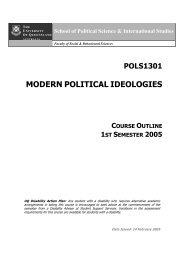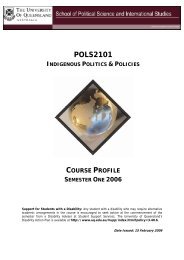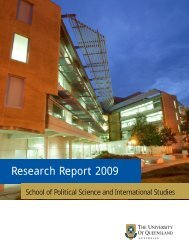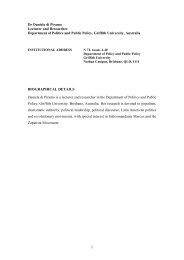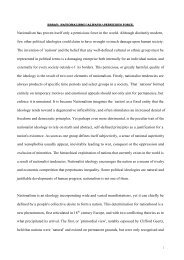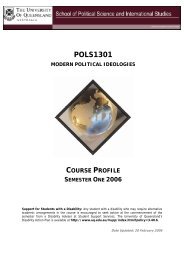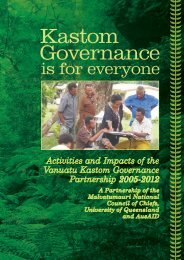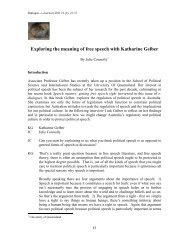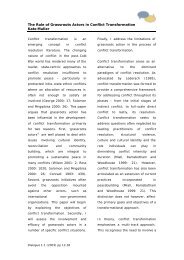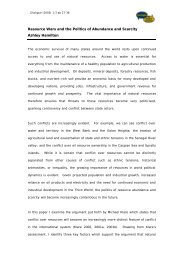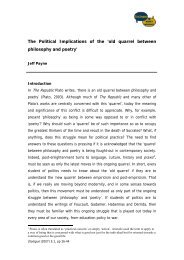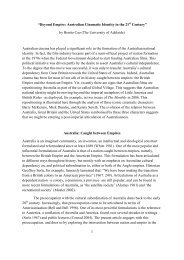Peace Support Operations: Lessons Learned? - School of Political ...
Peace Support Operations: Lessons Learned? - School of Political ...
Peace Support Operations: Lessons Learned? - School of Political ...
You also want an ePaper? Increase the reach of your titles
YUMPU automatically turns print PDFs into web optimized ePapers that Google loves.
PEACE SUPPORT OPERATIONS: LESSONS LEARNED?<br />
Shannon Tow<br />
in the longer term might preclude<br />
these lessons being translated into<br />
practice.<br />
Capabilities<br />
Admittedly, attempts to limit the<br />
mandate reflect past peacekeeping<br />
operations and the difficulties that<br />
resulted from the gap between<br />
mandate and means. In Rwanda, for<br />
instance, Force Commander Lieutenant<br />
General Romeo Dallaire requested<br />
4500 troops to meet warnings <strong>of</strong><br />
escalating violence between Hutus and<br />
Tustsis, yet was granted only 2500.<br />
This number proved insufficient to<br />
protect civilian populations in the<br />
ensuing genocide (<strong>Lessons</strong> <strong>Learned</strong><br />
Unit 1996). By addressing the issue <strong>of</strong><br />
variable consent, PSOs necessarily<br />
provide the framework and<br />
justification for the more ‘robust force’<br />
that the Brahimi Report advocates<br />
(United Nations General Assembly<br />
2000).<br />
INTERFET 4 represents a successful<br />
case in point. Continuing attacks by<br />
pro-Indonesian militias against the<br />
East Timorese population following the<br />
August 1999 referendum, impelled the<br />
UN to authorise Australia to forge a<br />
coalition-<strong>of</strong>-the-willing to intervene.<br />
Australia’s ties in the region enabled it<br />
to form a coalition force <strong>of</strong> ASEAN<br />
states (Cotton 2001: 131). Australia<br />
also provided advanced air and sea<br />
units for force protection and heavy<br />
armour and artillery enabling rapid<br />
deployment. These capabilities proved<br />
instrumental in countering TNI militias<br />
in East Timor (Breen 2000: 135).<br />
Although boasting higher overall<br />
capability levels than past<br />
peacekeeping missions, recent PSOs<br />
have simultaneously highlighted how<br />
this operational advantage might be<br />
threatened by deteriorating political<br />
will <strong>of</strong> peacekeeping forces over time.<br />
This is not only the case in fulfilling<br />
capability requirements promised but<br />
in sustaining these commitments for<br />
the duration <strong>of</strong> the mission. As ‘public<br />
interest’ in a particular conflict wanes,<br />
so too do member states’ willingness<br />
to provide capabilities, particularly as<br />
other national interests come to the<br />
fore (Mackinlay and Kent 1997: 34).<br />
This has devastating ramifications for<br />
PSOs. The key benefit <strong>of</strong> the PSO<br />
model is the ‘spectrum <strong>of</strong> conflict’ it<br />
uses to sustain peace and the implicit<br />
‘robust force’ necessary to realise this<br />
objective. Former KFOR Commander<br />
Klaus Reinhardt reflected the most<br />
difficult part <strong>of</strong> his mission was<br />
actually acquiring the money promised<br />
by member states for the operation<br />
(Reinhardt (2000) cited in Dorscher<br />
Dialogue 1:1 (2003) 4



